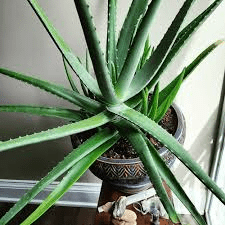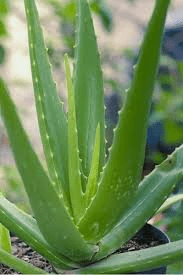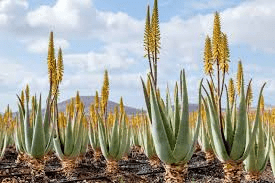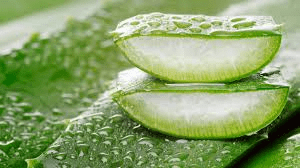There are over a hundred herbs and spices that can be consumed or used topically for healing, these natural foods possess a number of beneficial properties and work to reduce inflammation, improve the health of your heart, boost your immune system, and even prevent and fight cancer.
So, I suggest that you bulk up your spice cabinet and start cooking with fresh herbs that provide therapeutic components you probably didn’t realize were there.
There are also some more obscure herbs and spices that can be found in tea, extract, capsule and tablet forms to relieve specific conditions, from infertility and menopause symptoms, to diabetes, liver disease, cognitive decline etc. The possibilities are just limitless!
Meanwhile, today we will be discussing “Aloe Vera” and it’s Health Benefits on the body and is certain to be quite interesting:
Health Benefits of Aloe Vera
Did you know that Aloe Vera contains vitamins and minerals that are needed for the proper function of all body systems? It also contains enzymes, laxative compounds, anti-inflammatory fatty acids, and wound healing hormones.
Aloe Vera can also be used to soothe skin irritations, burns, wounds and rashes, treat cold sores, moisturize your hair and scalp and reduce inflammation when used topically, so if you have any of these health problems, all you need to do is simply locate the nearest Aloe Vera close to you and the problem is solved right?
When taken internally, Aloe Vera also works to relieve constipation, aid digestion, boost your immune system and even improve diabetes symptoms.
The therapeutic claims for Aloe Vera cover a broad range of conditions. It is commonly used topically in the treatment of dermatological and wound healing conditions.
The oral application of the Aloe Vera latex is promoted as a laxative, whereas gel and whole-leaf oral preparations have been variously recommended for use as an adjunct to chemotherapy treatment and to ameliorate diverse disorders such as DM, infectious diseases, metastatic cancer, and ulcerative colitis.
The clinical use of Aloe Vera is supported primarily by anecdotal evidence and case reports. The number of clinical trials exploring its effectiveness has begun to increase; however, a standardization of methodological trial quality has yet to be achieved.
On controlled Trials Investigating the Effectiveness of Aloe Vera in the Treatment of Various Health Conditions in Humans, The first case report of the beneficial effects of Aloe Vera in the treatment of skin and wound healing was published in 1935, with fresh whole-leaf extract reported to provide rapid relief from the itching and burning associated with severe roentgen (radiation) dermatitis and complete skin regeneration (Collins and Collins 1935).
Numerous subsequent reports have explored the role of topical Aloe Vera administration in skin conditions and wound healing management, including psoriasis, dermatitis, oral mucositis, burn injuries, and surgical wounds.
Read Also: The 15 Health Benefits of Sour-sop including its power to cure Diabetics
(1) Dermatological Conditions

Results of a number of clinical trials suggest that Aloe Vera is positively indicated in the treatment of skin disorders.
A trial of wound healing management after the full-faced dermabrasion of patients with acne vulgaris demonstrated that the saturation of a standard polyethylene wound gel dressing with Aloe Vera significantly reduced time to reepithelization compared to use of the standard dressing alone (Fulton 1990).
In a randomized, double-blind, controlled trial of Aloe vera or placebo cream in 60 patients with chronic psoriasis, the cure rate in the Aloe vera group was 83% (with no relapses at 12 months of follow-up) compared to only 7% in the placebo group (Syed et al. 1996).
Converse results were reported in a later trial examining the efficacy of a commercial Aloe vera gel preparation in the treatment of slight to moderate psoriasis vulgaris. The Aloe vera or placebo gel was applied twice daily for 4 weeks to symmetrical test lesions using an intraindividual right/left comparison study design.
The sum score of erythema, infiltration, and desquamation significantly favored the placebo treatment (Paulsen, Korsholm, and Brandrup 2005).
Further, despite case reports (Loveman 1937) and animal studies (Rowe 1940) to the contrary, Aloe vera extracts have either no effect or less effect than other topical treatments in acute radiation dermatitis.
In the first of two randomized controlled trials in 194 women receiving radiation therapy for breast cancer, the topical self-administration of Aloe Vera gel to radiation-exposed skin produced no difference in the severity of the dermatitis compared to a placebo gel.
In the second study, the placebo group was replaced with a “no-treatment” group to account for any unintended beneficial effects of the inert carrier gel used as the placebo in the first trial. The results failed to show any benefit of the Aloe Vera gel in preventing radiation-induced dermatitis (Williams, Burk, and Loprinzi 1996).
Similarly, in 70 radiation therapy patients who were randomized to receive either commercially available Aloe Vera gel or no treatment (other than mild soap), Aloe Vera did not significantly protect against radiation-induced skin changes (Olsen et al. 2001).
In a study involving 225 patients undergoing radiation therapy, the topical application of Aloe Vera gel thrice a day throughout the treatment and for an additional 2 weeks after the completion of radiation therapy was significantly less efficacious in reducing the treatment-related side effects than aqueous cream (Heggie et al. 2002)
In the pediatric setting, 45 patients undergoing radiation therapy for various diagnoses were treated with either an Aloe Vera–based gel or an anionic polar phospholipid (APP)-based cream applied symmetrically within the irradiated field after each session.
The authors reported statistically significant results favoring the APP-based cream on a number of skin assessment variables, including dryness, comfort, erythema, and peeling.
A 20 mL “swish and swallow” of Aloe Vera solution (94.5% aloe juice) four times daily in addition to conventional treatment (baking soda mouth rinse, Benadryl and nystatin combination mouth-washes, and viscous lidocaine, as needed) did not improve radiation-related mucositis in patients with head-and-neck neoplasms.
(2) Burn Injuries

Aloe Vera has long been associated with the treatment of burns. With the advent of nuclear power, the U.S. government conducted research on the ability of Aloe Vera to treat thermal and radiation burns with the aim of introducing its use into the military (Ashley et al. 1957).
In 1959, the U.S. Food and Drug Administration approved the use of Aloe Vera ointment as an over-the-counter medication for healing burns on the skin (Park and Lee 2006).
Heck et al. (1981) randomly assigned 18 patients with second-degree burns to be treated, after debridement, with gauze containing either Aloe Vera cream or Silvadene ointment.
The Aloe Vera group had a mean healing time of 13 days compared to 16 days in the Silvadene group; however, the difference did not reach statistical significance. In a recent meta-analysis, a statistically significant benefit of Aloe Vera for the treatment of burns was demonstrated.
Using the duration of wound healing as an outcome measure, the meta-analysis of the efficacy of Aloe Vera in burn wound healing concluded that Aloe Vera treatments reduced healing time by approximately 9 days compared to conventional treatment groups (p = .006; Maenthaisong et al. 2007).
Four controlled clinical trials (with a total of 371 subjects) met the inclusion criteria for the review. The four studies differed in their study design, intervention, and reported outcomes. The Aloe Vera preparations included fresh Aloe Vera mucilage, gauze saturated with 85% Aloe Vera gel, Aloe Vera cream, and 1% Aloe Vera powder wrapped with Vaseline gauze. None of the studies standardized the amount of active Aloe Vera ingredients administered.
The outcomes measured were wound healing time, described as time to complete epithelization or not defined; the success rate of wound healing; and epithelization rate. Note that, due to differences in Aloe Vera products and outcome measures used, it is difficult to draw a specific conclusion regarding the effect of Aloe Vera on burn healing.
Nonetheless, the results of the review combined with other evidence suggest that Aloe Vera preparations at a range of different doses are beneficial in the treatment of burn wounds.
(3) Surgical Wound Healing
Aloe Vera has been reported to accelerate postoperative wound healing in periodontal flap surgery. Conversely, a randomized controlled trial involving women with complications of wound healing after gynecological surgery found that the mean healing time in the conventional care group (53 days) was significantly shorter (p < .003) than in the Aloe Vera gel group (83 days).
The results of the trial must be interpreted with caution, as only 21 of 40 women completed the study and more patients were lost to follow-up from the gauze group (n = 12) than the Aloe Vera group (n = 5).
An intention-to-treat analysis was not performed (meaning that patients lost to follow-up were excluded from the analysis), which potentially introduces significant bias into the results.
Read Also: Health Benefits of Spinach (Spinacia oleracea)
(4) Oral Applications

Therapeutic claims promote the use of oral Aloe Vera in the treatment of a wide range of conditions, such as alopecia, Alzheimer’s disease, congenital heart failure, depression, glaucoma, hemorrhoids, hepatitis, multiple sclerosis, and varicose veins; however, scientific investigations of such claims are limited.
Claims that have been the subject of clinical trials include the oral application of Aloe Vera preparations in the treatment of constipation, DM, metastatic cancer, and ulcers and inflammation of the gastro-intestinal tract.
(5) Constipation (Laxative)
Aloe Vera latex is commonly used in the treatment of constipation; the laxative effect of the anthraquinone glycosides found in Aloe Vera latex is well established.
In a double-blind, randomized, controlled trial of 28 healthy adults, aloin was reported to have a laxative effect compared to a placebo that was stronger than the stimulant laxative phenolphthalein.
In subjects with chronic constipation, a novel preparation containing Aloe Vera, celandine, and psyllium was found to improve a range of constipation indicators (bowel movement frequency, consistency of stools, and laxative dependence) in a 28-day double-blind trial; however, the effect of Aloe Vera alone was not investigated in this study.
Aloe Vera laxative preparations have been approved by the German Commission E governmental regulatory agency for use in the treatment of constipation as a second-line agent; however, Aloe latex is no longer recognized as an over-the-counter drug by the U.S. Food and Drug Administration due to a lack of sufficient data to establish its safety for use as a laxative.
(6) Diabetes Mellitus
Aloe Vera is a traditional remedy for diabetes mellitus (DM) in many parts of the world, including Latin America and the Arabian Peninsula.
Some evidence in humans and animals suggests that Aloe Vera is able to alleviate the chronic hyperglycemia and perturbed lipid profile that are characteristic of DM, which are major risk factors for cardiovascular complications in the disease.
Agarwal (1985) reported hypoglycemic and hypolipidemic effects from the long-term dietary administration of 100 g of an Aloe Vera gel preparation combined with 20 g of psyllium seed husks.
The study involved 5000 patients aged 35–65 years with atheromatous heart disease, a population that included 3167 noninsulin-dependent diabetic patients.
Marked reductions were noted in serum cholesterol, triglycerides, and total lipid levels, along with an increase in high-density lipoprotein (HDL) cholesterol.
All but 177 of the diabetic patients demonstrated a normalization of fasting and postprandial blood glucose levels that necessitated the withdrawal of all oral hypoglycemic agents by the end of 2 months of therapy.
A beneficial effect of Aloe Vera gel alone on blood glucose and lipid parameters in diabetic subjects also has been demonstrated. In the first of two related clinical trials, 72 diabetic women without drug therapy were administered one tablespoon of Aloe Vera gel or placebo for 6 weeks.
Blood glucose and serum triglyceride levels were significantly decreased with Aloe Vera treatment, although cholesterol concentrations were unaffected.
In the second trial, the effects of Aloe Vera gel or placebo in combination with glibenclamide (a commonly prescribed antidiabetic medication) were investigated, similarly resulting in significant reductions in blood glucose and serum triglyceride concentrations in the Aloe Vera group.
In addition to gel preparations, Aloe Vera latex has been shown to lower fasting blood glucose levels in case studies of five patients with noninsulin-dependent DM.
Further, the whole-leaf Aloe Vera extract administered to 60 patients with hyperlipidemia in a 12-week controlled clinical trial resulted in significantly decreased levels of total serum cholesterol, triglycerides, and low-density lipoproteins.
However, although studies in humans provide promising preliminary data that denote a beneficial effect of Aloe Vera in diabetes and associated cardiovascular complications, effects have yet to be confirmed by controlled clinical trials that are both randomized and blinded to subjects and investigators.

Animal studies exploring the effects of Aloe Vera on blood glucose and lipids have demonstrated less consistent results likely due to different combinations of animal models and Aloe Vera preparations used.
In rodent models, both the chronic administration of Aloe Vera latex to alloxan-induced diabetic mice and Aloe Vera gel to streptozotocin (STZ)-induced diabetic rats resulted in significant reductions in fasting blood glucose.
Conversely, Aloe vera gel was reported to increase plasma glucose levels in alloxan-induced diabetic rats. More recently, the antidiabetic effects of processed Aloe Vera gel were investigated in mice exhibiting diet-induced obesity (DIO), an animal model that has been shown to demonstrate metabolic abnormalities that closely resemble those found in human noninsulin-dependent DM, including hyperglycemia, obesity, and insulin resistance.
Oral administration of the gel reduced circulating blood glucose concentrations to a normal level, significantly decreased plasma insulin, and lowered triglyceride levels in the liver and plasma of the DIO mice.
Similarly, Aloe Vera gel extract has been shown to normalize the fasting blood glucose and plasma insulin levels and reduce the concentrations of cholesterol, triglycerides, and free fatty acids in the plasma, liver, and kidney of STZ-induced diabetic rats.
Read Also: Health Benefits of Stubborn Grass (Sida Acuta)
(7) Metastatic Cancer

The concomitant oral administration of 1 mL twice a day of Aloe Vera tincture (10% Aloe Vera and 90% alcohol) and 20 mg/day of melatonin compared to melatonin alone was studied in 50 patients with locally advanced or metastatic solid tumors for whom no other effective standard therapy was available.
In the group treated with Aloe Vera and melatonin combined, 12 of 24 patients had their disease stabilized compared to only 7 of 26 patients in the melatonin-only group. In addition, the percentage of individuals surviving 1 year was significantly higher with Aloe Vera plus melatonin compared with melatonin treatment alon.
(8) Ulcers and Inflammation of the Gastrointestinal Tract
Aloe Vera preparations are widely promoted for the treatment of gastrointestinal disorders, including ulcers and inflammatory bowel disease, but evidence of their effectiveness is inconsistent.
In 1963, clinical evidence of the successful use of Aloe Vera gel (administered in a heavy liquid petrolatum emulsion) was reported for the treatment of 12 patients with peptic ulcers.
In a 3-month randomized controlled trial of 58 patients with irritable bowel syndrome, no evidence was found to suggest that Aloe Vera has any beneficial effect.
A recent attempt to formally evaluate the efficacy and safety of Aloe Vera gel in the treatment of ulcerative colitis produced encouraging, although not conclusive, results.
In a randomized controlled trial of 44 subjects with mild to moderately active ulcerative colitis, the oral administration twice daily of 100 mL Aloe Vera gel to 30 subjects for 4 weeks generated clinical remission and improvement more often than in the placebo group (14 subjects); however, despite positive trends the results failed to reach statistical significance.
The simple clinical colitis activity index and histological scores showed small statistically significant improvements in the Aloe Vera group.
Six patients (20%) who were given Aloe Vera gel and three patients (21%) who were given placebo withdrew from the study because of deterioration or a failure to improve sufficiently but were included in the statistical analyses.
The Aloe Vera preparation used in this study was reported to contain a high proportion (>95%) of Aloe Vera pulp, and the dose administered was the maximum recommended by the manufacturers.
No adverse effects were observed during the trial, and the authors note that a higher dose may have been more efficacious and suggest the need for further, larger controlled trials of Aloe Vera gel in active ulcerative colitis and in the maintenance of remission.
Read Also: Illegal Grazing/Logging and their Negative Effects on Forest and Wildlife
Frequently Asked Questions
We will update this section soon.
